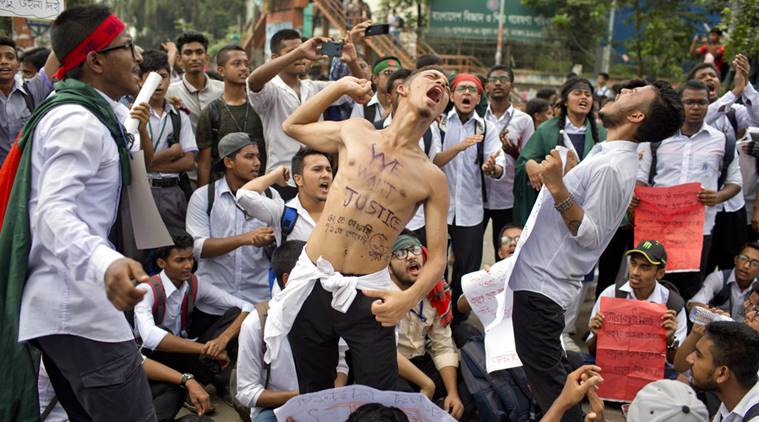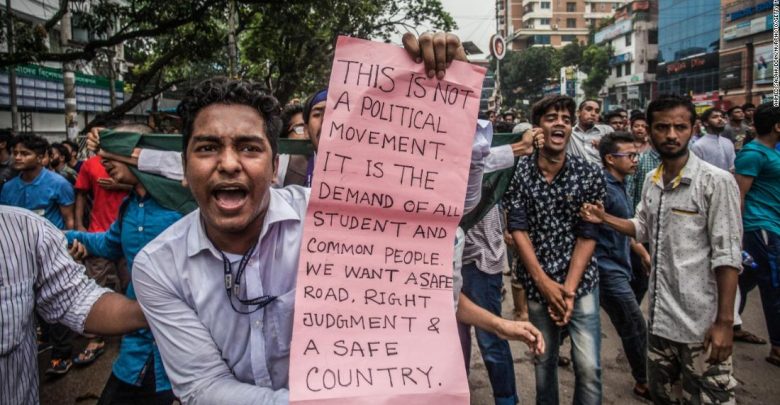The Bangladesh student protests have been grossly under reported by the South Asian news agencies. The protests, initially aimed at improving road discipline, have now become symbolic of the citizen’s right to speech and protest. In fact, I have seen more reports about the protests on Instagram posts than in formal news media.
Why are they protesting?
On 29th of July 2018, two school going children were killed by a speeding bus in Dhaka, along with 12 students who were injured. In a country which has at least 3000 road and traffic related accidents each year, this incident should have been lost in the ocean of others. However, it did not.
This incident kindled outrage which sparked huge student led protests in the capital city. Exhausted from the sheer numbers of road related accidents and death as well as the lack of interest from the government, the students carried out massive strikes which paralysed Dhaka.

Image Source: BBC
A report by the Bangladesh Passengers Welfare Association claims that road accidents took almost 7,400 lives last year, with almost 16,000 people left injured. The 29th July protests was the manifestation of a long history of corrupt, unregulated and dangerous Bangladeshi transport sector. Students identify road safety and transport discipline as a fundamental duty of the government to ensure. Security in public spaces, especially roads is a basic right of citizens. One should not fear for their lives as they walk down the streets.
The protests, initially aimed at improving road discipline, have now become symbolic of the citizen’s right to speech and protest.
However, analysts such as Michael Kugelman, a South Asia expert at the Washington-based Woodrow Wilson Centre, says that these protests are an expression of anger against the much larger issues in the Bangladeshi government systems. They claim that the protests under the garb or traffic safety is an attack on the broader issues such as the lack of accountability of the government and the absence of the rule of law.
Shahidul Alam, a prominent human rights activist and photographer told Al Jazeera that the protests were driven by “larger” factors, such as “the looting of banks, the gagging of the media, the extrajudicial killings, disappearings, bribery and corruption”. His words may not be without reason and worth, as almost immediately after making this statement he was kept under house arrest.
The Protests and Violence
The protests that began on the 29th of July turned violent the following weekend. Minister Shahjahan Khan commented asking why there was such an uproar over two Dhaka children when there was no such reaction to the death of 33 Indians who were killed in a bus accident on the Mumbai-Goa highway. This callousness added fuel to the student agitation, which then called for his resignation and apology.
On Saturday, the government began taking strong measures to disperse the protesters and end the strike which brought Dhaka to standstill. The protests turned violent as the police began using tear gas, rubber bullets and batons to disperse protestors outside Dhaka University. On Saturday, more than 100 students were hurt by the police. On Sunday, the protestors attacked the car of the US Ambassador, Marcia Bernicat. Though the diplomat was unhurt, this brought the protests to the attention of the US, who condemned the oppressive and violent reaction of the Bangladeshi government.

Image Source: Indian Express
Furthermore, these protests were heavily politicised as clashes erupted between the student protesters and pro-government student groups such as Bangladesh Chhatra League (BCL) which is linked to the ruling Awami League Party. There have been reports of BCL members harassing and attacking the students, including gouging out the eyes of a protester and sexually harassing female students. Several journalists too have been harassed and threatened from publishing the materials they have recorded.
Also Read: In Photos: When Thousands Marched Together To #StandWithJNU And Save Democracy
In an attempt to restrict the coordination and communications which fuel the movement, the government has blocked all mobile data services in Dhaka, preventing any information of the situation from being spread to regions outside the capital. News agencies were also restricted from fully reporting the events in Dhaka, lest the rest of Bangladesh joins in the protests, treating the ruling party’s position before the new elections.
Such reaction from the Bangladeshi government has shown the tyrannical rule of the Awami League Party, and the tendency of the government to retract the holy grail of democracy, the right to speech and dissent, at their whim and fancy.
Road Transport Act 2018
On Monday, 6th August 2018, the Bangladeshi cabinet approved road safety regulations, Road Transport Act 2018. This Act proposes that if death by road accident is proved to be intentional, the offender is to be tried and sentenced as a murder suspect, with such road related crimes being a non bailable offence. Law Minister Anisul Huq also told CNN that the new law will extend the maximum sentence to 5 years and a monetary fine for offences such as reckless driving. The Act is now awaiting parliamentary approval and is an attempt to pacify the protesting students.
However, if these protests are not simply against the lack of road safety, but an attempt to undermine the structure that is corrupt, discriminatory and undemocratic, the Road Transport Act maybe like a bandaid on a broken bone.
The children’s rights of road safety, as well as their right to an responsible and compassionate government is fundamental.
Students have been told till their ears bled that they are the future of their country, that they must aim to change their societies for the better. However, when the teenage school students of Bangladesh took these instructions to heart, they were met with oppression and state funded violence.
Their battle cry #WeWantJustice should bring pride to their parents, teachers and government in their own ability to raise such socially aware and active citizens. It indicates knowledge of their rights and duties as citizens of a democracy, as well as their commitment to such ideals. The children’s rights of road safety, as well as their right to an responsible and compassionate government is fundamental. Above all else, the Bangladesh student protests have shown that voices fuelled by reason and passion cannot be ignored just because of their ages.
Also Read: Merit In The Time Of Nationalism: Why University Protests Matter
Featured Image Source: Autoblog
About the author(s)
Leah is pursuing a bachelors degree in social science. She feels very strongly against the binary perception of gender and sexuality as well as the oppression stemming from the economic class systems.




